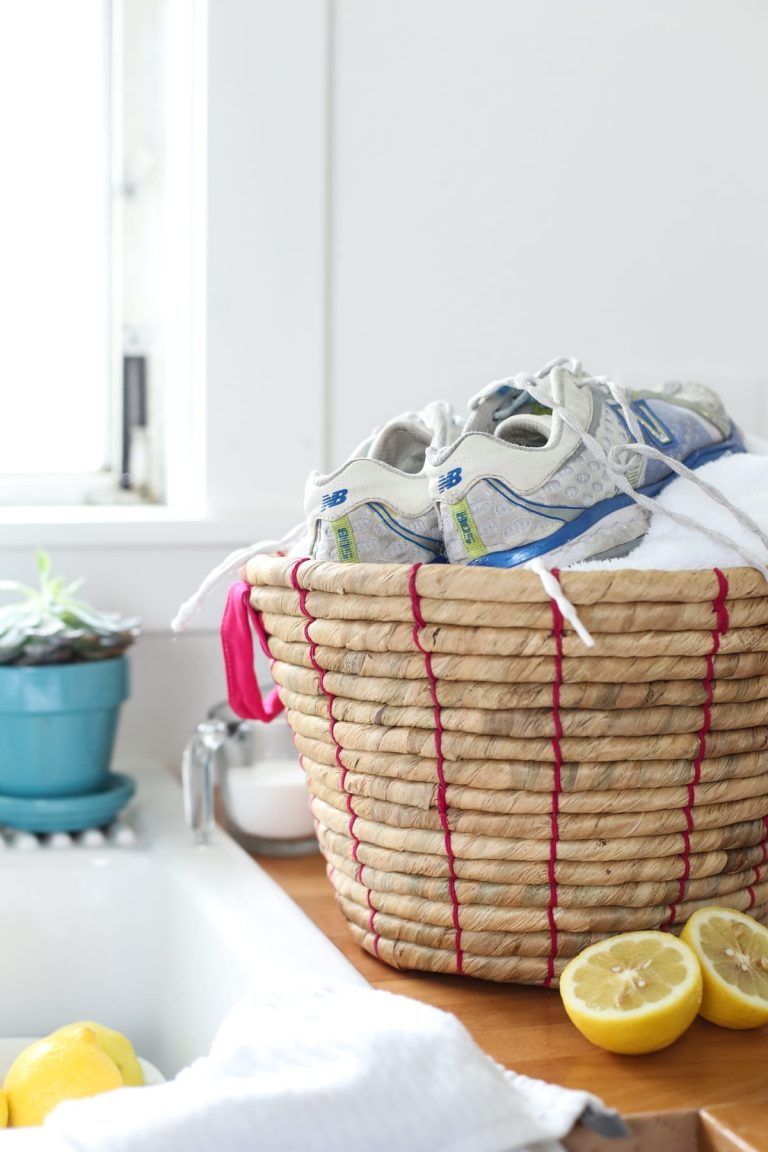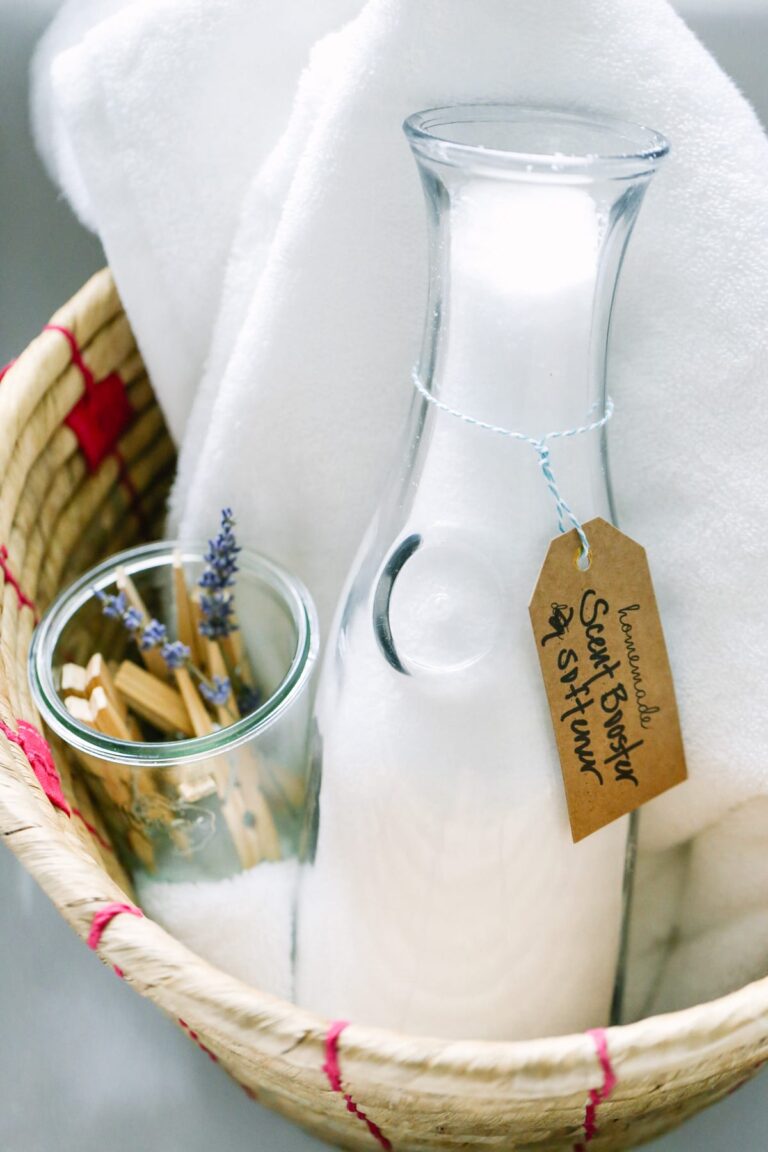
Want to Save This Article?
Enter your email & I’ll send it straight to your inbox. And you’ll get new recipes & tips each week.
There are so many amazing benefits to enjoying a real food lifestyle (AKA: getting back to great-great grandma’s food). While the benefits may be numerous, there’s always one big drawback to this lifestyle: dishes!
Dirty dishes, and lots of them, are just a way of life for a real food family. Sure, eating processed food means dirty dishes will accumulate in the sink, but usually this means just a few plates or a bowl (for that boxed cereal or toaster “pastry”). Enjoying “real food” means a family must stock basic ingredients and turn those ingredients into wholesome and delicious meals. This means bowls, skillets, knives, cutting boards, and whisks will be dirtied in the process.

Here’s where natural living and real food merge together when it comes to tackling those dishes…
If enjoying real food means cooking and sometimes baking (PS: Did you make the blueberry muffins yet? Just one bowl is required.), a good grease-cutting, hard-working, nothing-left-behind dish soap is a major necessity. And this is where the dilemma begins…
Should I purchase the blue dish soap? It gets a D rating from the EWG.
Should I try out every “more natural” store-bought dish soap until I find one that gets the job done?
Should I try to make a do-it-yourself soap?
What about just castile soap? It seems to work on just about everything in my house.

Friend, I’m not here to answer those questions for you. I hope to provide you with a little insight, through today’s recipe post, into what I’m currently using to clean my mountain-like pile of daily dishes.
The truth is, what’s best for you and your family is a decision that you need to make, whether this means sourcing a cleaner store-bought soap (check out the EWG for the best rated “cleaner” dish soap options) or making a do-it-yourself dish soap. But know this: There are effective dish soap alternatives to the low-graded (according to the EWG) dish soaps that sit in so many American homes, and a do-it-yourself soap is a great alternative option.

Last year I shared a dish soap recipe on the blog titled, Easy Dish Soap. That recipe truly is easy to make, but after months and months of making that soap, I decided there must be an even easier way to make dish soap, a super easy dish soap.
The key ingredient in my first dish soap recipe is Sal Suds, castile soap’s big and super strong brother. With that ingredient, I started to experiment with different combinations, and finally discovered just about the simplest dish soap formula that can be made at home. Simple and effective dish soap that takes less than one minute to make? Yes, please!!!

Let’s take a look at the 3 ingredients in this DIY dish soap…
Sal Suds: Sal Suds is Dr. Bronner’s tougher version of soap, although its chemical makeup makes it a detergent, not a soap (which is why it works so well to cut grease). Sal Suds is formulated to conquer tough cleaning projects, like sticky grease and stubborn dirt. Sal Suds is a hot topic in the natural community, so it remains a product that some people use and others stay away from. What’s all the fuss about? Sal Suds receives an A grade on the Environmental Working Group’s website. You can also read more about the big SLS debate on Lisa Bronner’s blog.
Sal Suds is highly concentrated, so it’s diluted in this recipe with water. You’re welcome to play around with a water to Sal Suds ratio that yields the best results for your dishes. I’ve found that a 1:1 ratio works best for me.
Castile soap doesn’t provide enough grease-cutting power to be considered an effective dish soap, in my opinion. If you’d like to try using castile soap in this recipe, then you’ll want to leave out the vinegar, but again, I don’t believe you’re going to get the grease-fighting power most people look for in a good dish soap.
Vinegar: Yep, good ol’ white vinegar. Unlike castile soap, Sal Suds may be combined with vinegar (another reason why Sal Suds is a great cleaning ingredient). We have really hard water, which means we deal with a lot of spotting on our dishes, even when we used the blue dish soap. I’ve found the vinegar in this recipe works like a rinse-aid to reduce some of the spotting that may occur from hard water. You’re welcome to leave this ingredient out of the recipe, but I personally prefer to add it.
Moisturizing Oil: This is another optional ingredient. Since this dish soap sits next to our sink, it’s also used as a hand soap on occasion, and particularly when Dustin’s been working in the garage (hello, dirty and greasy hands). I like to add a skin-loving oil to this soap to help take away the harsh soap feel since it’s being used on our bare hands. Water and oil don’t mix, so this oil rests on top of the dish soap until we shake the soap dispenser.
The color of your oil will change the color of your final product. If you use a deep yellow oil, like jojoba or olive oil, then your soap will have a slight yellow hue. If you use something like fractionated coconut oil, then your soap will remain clear. In the future, I’d like to play around with adding aloe vera gel (probably a couple of tablespoons) or vitamin E oil (probably a teaspoon) instead of the oil.

I may not be able to help you tackle that pile of glorious dishes (just think of the amazing food that you’ve made with those dishes!), but I can share my dish soap recipe to help you get those dishes squeaky clean.

Super Easy DIY Dish Soap: 3 Ingredients
Equipment
- 1 8-ounce soap dispenser or 16-ounce soap dispenser
Ingredients
- 1/2 cup distilled water
- 1 TB white distilled vinegar optional
- 1/2 cup Sal Suds This ingredient is also available at most health food stores.
- 1 TB jojoba oil or other moisturizing oil: sweet almond, fractionated coconut oil, or olive oil, optional
Special Equipment:
Instructions
- Pour the water and vinegar (if using) into a soap dispenser (like this).
- Shake the bottle to combine the ingredients. Add the Sal Suds and oil (if using), and gently shake the bottle again to combine the ingredients. There may be bubbles at the top of the dish soap after shaking the bottle. This is completely normal.







Good recipe. But wondering if there’s an alternative to Sal Suds? It is quite expensive than my normal, brand name, non-toxic dish soap I buy. So justifying making this instead of just buying it is hard to do when it costs over $1 extra per oz. Does another company sell Sal Suds or something like it I can use instead? Thanks!
Hey Kelsey, There’s no replacement, unfortunately. You can use castile soap, just don’t dilute as much and don’t use vinegar. But it’s not as tough on grease.
Diluting something from a single use plastic bottle doesn’t feel like saving the planet.
Hey Sarah, Thanks for sharing, but you clearly don’t understand how castile soap or Sal Suds work. They are a highly concentrated soap/detergent meant to be diluted to make multiple cleaning products. Also, I don’t think I ever talked about my desire to “save the planet” with this recipe. Maybe that’s your intention with making a dish soap, and if so, then there are stores where you can fill your own glass bottle with castile soap (or Sal Suds) because they purchase in bulk amounts and then use it to make a dish soap. They’re generally called “zero waste” stores. Best of luck on your journey. Hope you find the recipe you’re looking for.
Sal Suds contains SLS 🥴
Hey Lauren, Highly recommend doing more research on this. Here’s a great place to start: https://www.lisabronner.com/there-is-no-cancer-risk-from-sls-sodium-lauryl-sulfate/
Love this! Thanks for sharing!
Is this recipe dishwasher safe?
Hey Sharna, It isn’t. Here are my favorite dishwasher soaps: https://livesimply.me/switching-products-natural-dish-dishwasher-soaps/ There’s also a homemade dishwasher soap in my cleaning book: https://livesimply.me/diy-natural-cleaning/
Hello! Very new to your recipes but interested in trying them. I was wondering if you did your experimenting with moisturizer oil? How much do you add with your recipe?
Hi Heathe, I would add about a tablespoon if desired.
LS Team
I add diluted castile soap and water in the ratio of 1/1. The result is terrible. There is no foam any more!! Any idea how I can have more foam?
Hi Bella, so foam doesn’t = clean. But if you’d like more foam, increase the amount of sal suds.
LS Team
This may be a random question that doesn’t really relate to this recipe (which I am DEFINITELY going to make once we run out of soap) but do you mind telling me what the best oil to use for diy products please? When you can use different types like jojoba or sweet almond I don’t really don’t know the difference. Also, the dish soap that we use is hard on our hands is this one softer and better for your hands? Thank you!
Hey Anna, All of them work equally well in cleaning recipes, IMO. That’s why I give different options, I recommend using what you have. You can even use olive oil. Where it becomes really important is in skincare recipes, some are lighter than others and work with different types of skin. In this recipe, grapeseed would be the lightest option, then sweet almond and jojoba and olive oil.
Love this dish soap. Easy to make and it works. Thank you
Thanks for sharing, Maple. I’m glad you’re enjoying the dish soap.
It looks like Sal Suds is in a plastic container. I’m trying to eliminate using plastic so do you have an alternative to Sal Suds in a natural container.
Hi Rita,
Yes, your best option is to find a reusable shop in your area that sells castile soap, laundry soaps, and Sal suds in bulk. Then you can bring your own containers to fill up. Another option is to buy the soap in bulk so you’re using less plastic.
LS Team
Hi can you explain/help me with the oil always rising to the top? I followed your recipe but the jojoba oil keeps rising to the top. So I just shake it but wondering if I did something wrong or if this is normal.
Hey Melissa, This is because oil and water don’t remain mixed unless you have an emulsifier. Just gently shake the bottle each time.
Hi Kristin,
Thanks so much for this effective, cost efficient recipe? I’m just wondering how many squirts of liquid you use for each washing? I want to be sure I’m using enough and not too much.
Hi Amy, I use one squirt on a rag every few dishes.
LS Team
Hi Kristin,
I was using castile soap, Marseille soap and all sorts of bar soaps, but none of them really work that well with grease. Then, I came across with your site and gave it a try. This is the soap I’m going to use for dishes forever from now on. It cleans grease really well and so easy and cost efficient to make, and, the best of all, very eco-friendly. I bought a gallon of Sal suds, so I’m set for a long while. 🙂
Thank you for sharing this recipe!
So glad you’re enjoying it, R KLB! Yea, castile just doesn’t work great on tough grease.